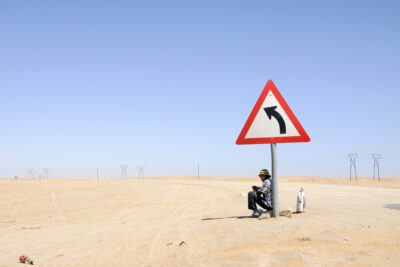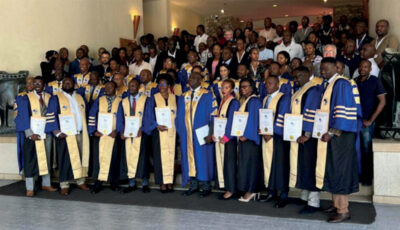Main content
Burn injuries are a common cause of trauma in Africa. The injuries are often severe and contribute to major morbidity and mortality. Children are most vulnerable to sustaining burns. The World Health Organization (WHO) estimates that between 15,000 and 30,000 children under the age of 5 years die of fire-related injuries in Sub-Saharan Africa annually.[1]
Burn care is complex even in well-equipped centres in high-income countries (HIC). Lack of prevention programmes, poverty, co-morbidity, ignorance, and cultural beliefs all influence the incidence of burn injuries as well as the outcome. In many African countries, an individual with an epileptic fit who falls into a fire is thought to be bewitched and will not be pulled from the flames until the shaking stops resulting in devastating burns. [2] (Figure 1)
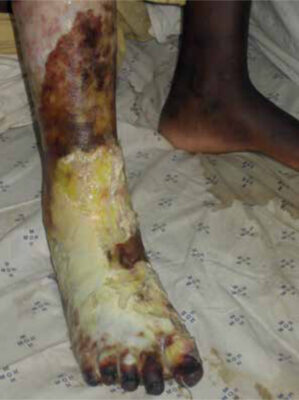
Burn care is usually poorly organized and suffers from shortage of supplies, poorly educated staff, and lack of commitment from the health authorities. [1] In general, health facilities are under-equipped for adequate management. Although in recent years more burn centres in Africa have been established, for example in Ethiopia, Kenya, Ghana and Malawi, these are at a central level and people from the rural areas often do not have access because of cost and lack of transport. Instead they visit a traditional healer first, causing further delay and increased risk of adverse outcome such as infection. Therefore, patients with burn injuries often present late in local hospitals and do not receive proper first-line treatment. [1,2,3]
The acute management of burns
Burn injuries require special care by well-trained health workers. The Early Management Severe Burns (EMSB) course is now widely accepted as the standard of required training for nursing and medical staff. [4]
This one-day course has been established in Australia to help with triage and transfer of a victim with severe burns to a burn centre. It is based on the ABCDE (Airway, Breathing, Circulation, Disability) primary assessment. After this, ‘Exposure‘ follows where temperature, assessment of the total burned surface area (TBSA), depth and site of the burn are reviewed. Other topics include effective resuscitation, early transfer to a specialist burn centre, intensive care for inhalation injury, skill stations and interactive discussion groups. In the Netherlands and in South Africa for example, this course is very successful and led to a dramatically improved outcome. [4] In most African countries this course has not yet been introduced.
First aid and assessment
First aid of burn injuries follows the same procedure worldwide: stopping the burning process, removal of clothing and cooling the burn. [5,6]
Thereafter assessment of the injury is performed: where is the burn, how big is the burn, how deep is the burn? These questions help a practitioner to follow the right procedure in treating burn patients.
Cooling
The Dutch Burns Foundation started an awareness campaign many years ago: ‘First water and the rest comes later‘. This slogan has become well known in the Netherlands. Guidelines all indicate that cooling the burn with lukewarm water for a period of not more than 10 minutes is the first management (longer cooling may induce hypothermia) that should be started immediately. [5,6,7] In Africa this is not common knowledge. Instead of water, other substances are used such as flour, soil, mud, toothpaste, crushed snails, egg yolk, butter, palm oil, cow dung, tea leaves and forms of traditional medicine. There is an increased risk of tetanus with the use of cow dung or soil. [8] In practice, because of ignorance and delay in presentation, cooling is often not done, with an increased risk of a deeper burn and secondary infection leading to higher morbidity and mortality. [7]
Where is the burn?
Deep burns covering the joints may result in contractures and early surgical management may prevent disability. Facial burns are often associated with inhalation injury and may need artificial ventilation; eyelids are fragile and an ectropion may develop. Perineal and genital burns may require a urinary catheter and proper nursing care to prevent infection. [7]
How big is the burn?
It is important to estimate the percentage of the Total Burned Surface Area (TBSA) with regard to the risk for hypovolemic shock due to increased fluid loss. The Rule of Nine is most commonly known but difficult to use, especially in children because of body changes with increasing age and growth of the child (Figure 2). Therefore the 1% hand rule has been introduced. The closed hand with the palmar surface of the patient represents 1% TBSA and gives a reliable estimation of the TBSA. In Africa, a TBSA of more than 30% is life threatening because of hypovolemic shock, sepsis and anaemia, and in extensive burns with TBSA > 50%, the outcome is invariably fatal and comfort care in the patient’s own environment is advised. [7.9] In contrast, patients in HICs with TBSA > 50% are managed with ICU admission and this condition is not necessarily life threatening.

How deep is the burn?
The depth of the burn determines if a surgical or conservative approach should be initiated. Furthermore, a circumferential deep burn may lead to loss of a limb and urgent escharotomy is indicated to relieve the pressure. [5] (Table 1, Figure 3 a,b,c)
| Epidermal (e.g. sunburn, flash burn) | Superficial dermal burns (Partial thickness) | Deep dermal burns (Deep partial thickness) | Full thickness | |
|---|---|---|---|---|
| Pathology | Involves epidermis only | Epidermis and upper dermis | Epidermis and part of dermis | Epidermis, dermis |
| Appearance | Dry and red | Pale pink, wet. Wound base blanches with pressure | Blotchy red or pale deeper dermis where blisters have ruptured | White waxy charred |
| Sensation | May be painful | Increased, very painful | decreased | – |
| Circulation | Normal | Rapid capillary refill | Sluggish capillary refill | – |
| Colour | Red, warm | Pink | White/pink pale/botchy red | White/ charred/ black |
| Blisters | – | + | Early, large blister which rupture rapidly | – |
| Healing time | Within 7 days | 7-14 days | Over 21 days | Does not heal spontaneously |
| Scarring | No scar | Colour match defect, low risk of scarring | High risk of hypertrophic scarring | Wound contraction. Heals by secondary intention |
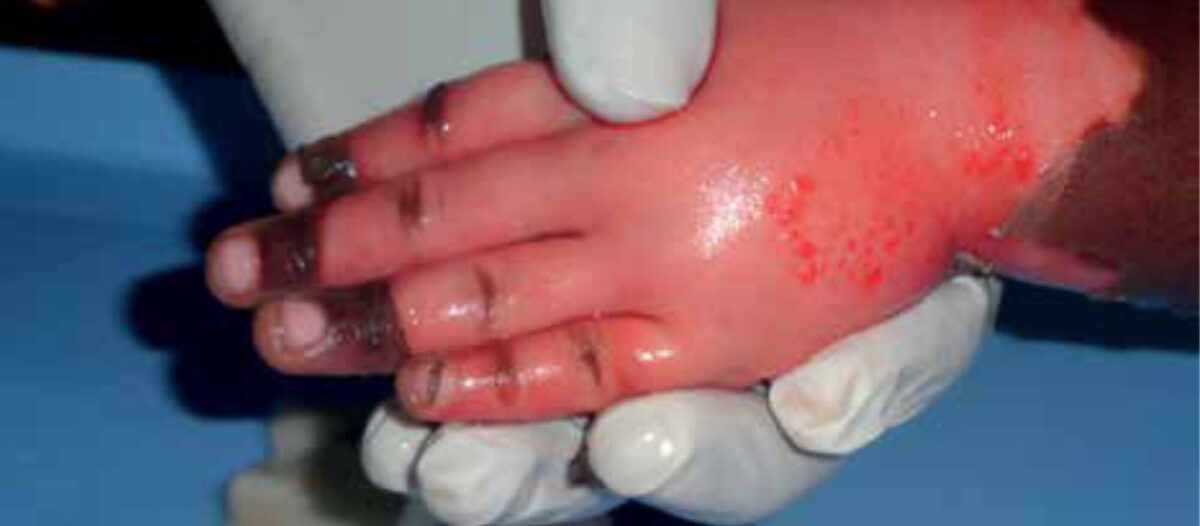
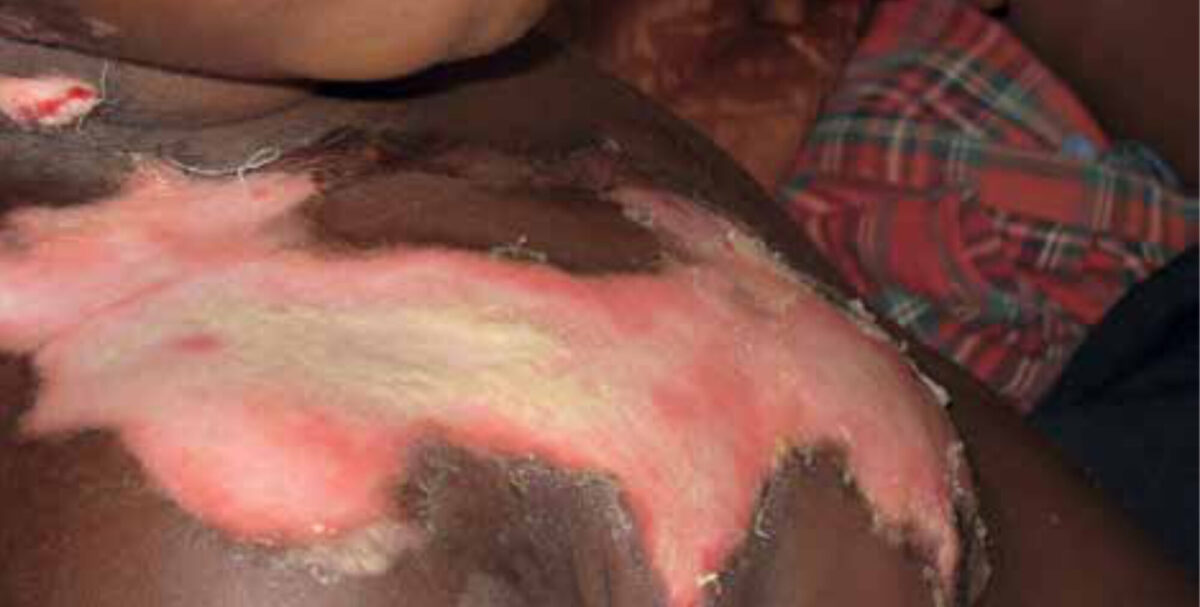

Early management – key points
Fluid resuscitation
If the TBSA in an adult is >20% (or >15% in children), intravenous (IV) treatment with normal saline or Ringer’s lactate should be started. If this is not available, Oral Rehydration Salt (ORS) may be given instead. Similarly, ICU monitoring of severe burns is not available in most settings. Nurses on the unit should insert a catheter and monitor the urine output. If patients arrive with a delay of a few hours, IV treatment should be started. If there is a delay of more than one day, the patient is first reviewed and treated accordingly. [5,6,7]
Pain management
Pain management is often a problem in LMICs. Burn injuries can be extremely painful and adequate pain management is needed. Opioids are not widely available and medication is often restricted to paracetamol, 3-4- times daily. [5]
Prevention of hypothermia
To prevent hypothermia, especially in children, nursing in a warm room, without fan or air-conditioning is indicated until the wound is covered. Bed cages are used to prevent sticking of the blankets or sheets to the wound. Extra blankets should be distributed especially if the wounds are exposed. [5]
Wound cleaning
If there is a delay in referral, cleaning the wounds, with (boiled) water, or normal saline or a fluid with antiseptic is advisable. Experience shows that nurses in LMIC clean the wounds very thoroughly; however, this can be very painful. After cleaning, the burn should be dressed. Leaving the burn open, ‘exposure treatment‘, is not widely performed although it prevents a lot of pain; the exposure is continued until the crust of the burn cracks, usually 4-5 days, which should then be removed. [1,7]
Identify co-morbidity
In LMICs, co-morbidity such as malnutrition and HIV infection are typical risk factors for slow wound healing and increased risk of infection or sepsis and should be managed appropriately from the start. [7,10]
After early management
Wound dressing
As silver-impregnated bandages are often not available, traditional remedies are used including the use of plants such as banana leaves for wound dressing. Other plant materials include papaya (Carcia Papya), honey and palm oil. Basic burn dressing can be done with petroleum jelly gauzes. The vaseline gauze does not stick to the wound, not interfering with the wound healing and maintaining a moist wound environment. [1,7]
Pain management
Optimal pain management should be continued, particularly during change of dressings. Ketamine is often used for sedation, with careful monitoring of the airway and breathing. [7]
Nutrition
High energy and high protein intake are necessary from admission. Peanut butter, high-energy milk or porridge with extra oil and sugar may be used. Vitamin supplements (particularly A, C and D) are recommended.[7,11]
Surgical intervention
Deep burns need early excision but due to lack of surgical capacity and blood transfusion or in case of wound infection operations are often cancelled or postponed. [1,7]
Hyperthermia
Burn patients often have raised temperature (typically 38-39 °C); this may be due to wound infection, or a concurrent infection (e.g. malaria), or due to the evolving burn wound or hypermetabolism induced by a large burn. [7]
Aftercare
Aftercare is of utmost importance for scar management (e.g. pressure garments, pruritus treatment) and psychosocial support, but this is not commonly available in LMICs. Typically, patients seek follow-up only in the case of contractures or keloid development (which is common in Africans).
The way forward
Emphasis should be on prevention campaigns such as safe cooking and first-aid measures. Resources for education and improved care are needed.[12] Research in the traditional medicine for burn care such as banana leaves, honey and papaya seems warranted.
Telemedicine may fill a gap in communication between the field and specialized centres, even abroad. [13] It is then essential that the health professional consulted should be aware of the limitations of working in burn care in LMICs.
References
- Albertyn R, Numanoglu A, Rode H. Pediatric burn care in Sub-Saharan Africa. Afr J Trauma 2014; 3: 61-67.
- Baskind R, Birbeck GL. Epilepsy-associated stigma in sub-Saharan Africa: The social landscape of a disease. Epilepsy Behav 2005; 7: 68-73.
- Stevenson J, Borgstein E, van Hasselt E, Falconer I. The establishment of a burns unit in a develop-ing country – A collaborative venture in Malawi. J Plast Reconstr Aesthet Surg 1999; 52: 488-94.
- Rogers AD, Allorto NL, Wallis LA, Rode H. The Emergency Management of Severe Burns course in South Africa. S Afr J Surg. 2013;51(1):38.
- ISBI Practice Guidelines for Burn Care. Burns 2016;42 (5): 953-1021.
- Nederlandse Brandwonden Stichting: Richtli-jnen opvang en behandeling brandwondenpati-enten. Available at: https://brandwondenzorg.nl/voor-zorgprofessionals/richtlijnen/
- Van Hasselt EJ. Burns manual, a manual for health workers. Dutch Burn Foundation 2008, 2nd edition.
- Kattan K, Alshomer F, Alhujayri A, et al. Cur-rent knowledge of burn injury first aid prac-tices and applied traditional remedies: a nation-wide survey. Burns & Trauma. 2016; 4: 37.
- Tyson AF, Boschini L, Kiser M, et al. Survival after burn in a sub-Saharan burn unit: Challenges and opportunities. Burns. 2013 Dec;39(8):1619-25
- James J, Hofland H, Borgenstein E, et al. The prevalence of HIV infection among burn pa-tients in a burns unit in Malawi and its influ-ence on outcome. Burns 2003; 29: 55-60.
- Prelack K, Dylewski M, Sheridan R. Practical guidelines for nutritional management of burn injury and recovery. Burns 2007; 33: 14-24.
- Van der Merwe A, Steenkamp WC. Preven-tion of burns in developing countries. Ann Burns Fire Disasters. 2012; 31; 25: 188-191.
- Klingberg A, Wallis LA, Hasselberg M, Yen P, Fritzell S. Teleconsultation using mobile phones for diagnosis and acute care of burn injuries among emergency physicians: mixed-methods study. JMIR Mhealth Uhealth. 2018; 6: e11076.


















































